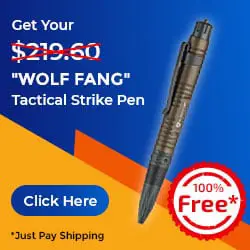FREE Tactical Pen
You can get this lightweight, powerful, and extremely durable Tactical Pen for FREE right now! Just pay a small fee for shipping… But ONLY while supplies last!
Whether you choose to utilize steel core or ceramic plating in your body armor, there is a vital decision to be made in the different cuts most often available. The two most popular cuts for plating come in the forms of SAPI (Small Arms Protective Insert) and the Shooter’s Cut. SAPI and Shooter’s Cut body armor are different in design and how they fit. In addition to these two factors, there are several main differences in SAPI vs. Shooter’s Cut body armor:
- Weight
- Protection
- Price
- Use
In this article, we’ll outline how these two styles are different and their benefits. Additionally, we will dive into the reasons for their development and what situations you may find them useful. Read on to find out the differences between Sapi vs. Shooter’s Cut.
SAPI vs. Shooter’s Cut
SAPI body armor was originally a class of body armor that could be cut in different ways, such as a shooter’s cut or swimmer’s cut. In recent years SAPI has taken on a different meaning and is now representative of a specific style of cut. Most similar in nature to a shooters cut but without as steep of a cut angle. You can see the differences in the below graphic.
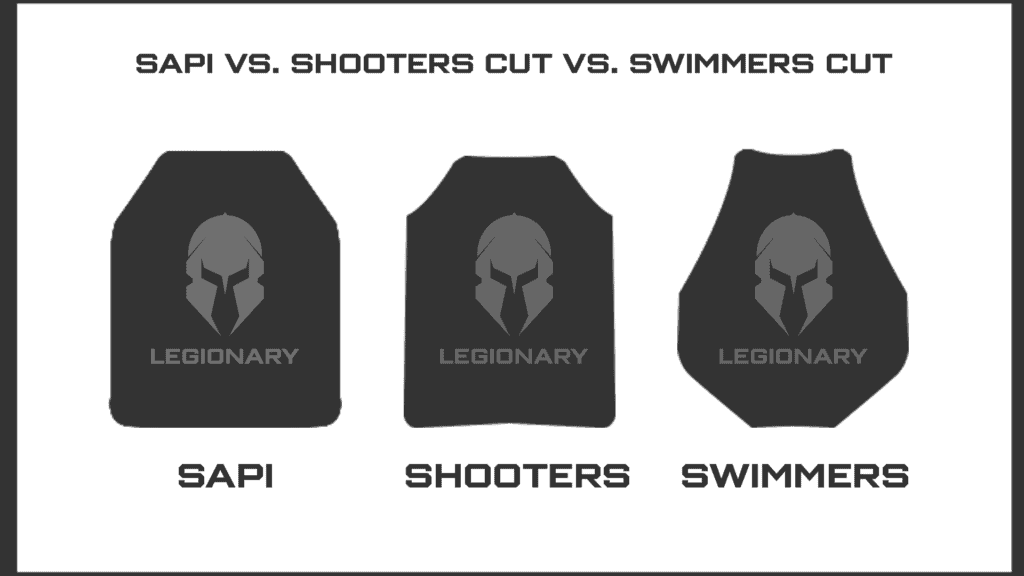
What Are SAPI Cut Inserts?
Initially designed by military engineers for use within the US armed forces, SAPI stands for Small Arms Protective Insert. When inserted into soft body armor, these plates are designed to halt smaller rounds such as a 5.56 NATO, at level III grade. Higher-grade armor can increase protection through ballistic technology developments while still utilizing the same body armor insert locations at a higher cost and weight. SAPI style plate cuts are a system of five different plates used in various locations. They are not found too often within civilian markets but are the standard within the US Military. SAPI inserts offer a 45 degree cut down the shoulders and include some different styles for the inserts.
This style makes shouldering a rifle comfortable while still delivering considerable protection to the vital organs of your chest. Rounded corners provide flexibility while not cutting into your body. A significant drawback of SAPI cut is that it can impede the comfort of shouldering a rifle for long periods when properly fitted. The increased weight can be considered a burden that does not outweigh the advantages due to the extra protection.
How do ESAPI Plate Inserts Fit In?
Enhance Small Arms Protective Insert (ESAPI) is an advanced form of a protective plate not ordinarily available to civilians. Producers create ESAPI plates with boron carbide ceramic that increases protection without having to increase weight. Lightweight and able to withstand larger caliber rifle rounds, the ESAPI plates often cost nearly 50% more to produce than traditional ceramics. It is because of this price increase and rare case usage you will very rarely find them stocked.
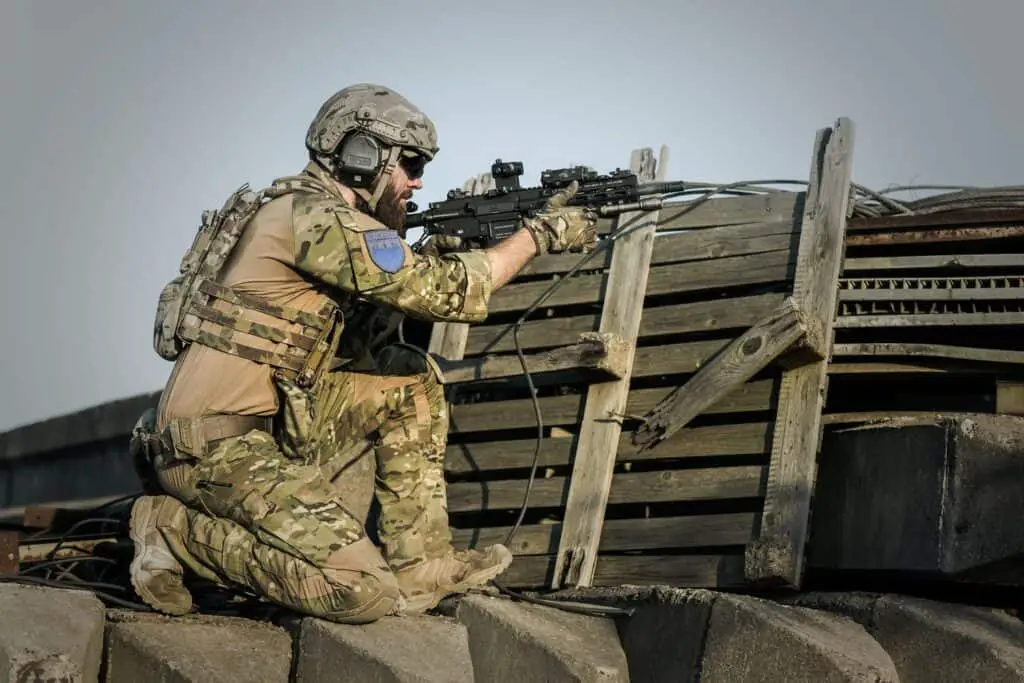
What Are Shooter’s Cut Inserts?
Shooter’s Cut is the most popular for private citizens to purchase and offers different benefits than the SAPI set. The Shooter’s Cut is a modified design of the original small arms insert and was developed by armorers to be worn in the armor’s front. The 45-degree Cut moved slightly lower than a full cut, removing a bit of the upper chest and shoulder protection.
The Shooter’s Cut is suitable for those who want to shoulder their rifle without a plate getting in the way. It is far more comfortable than most plating and is lighter than SAPI. The shooter’s Cut balances protection, weight, and effectiveness pretty equally for multipurpose use.
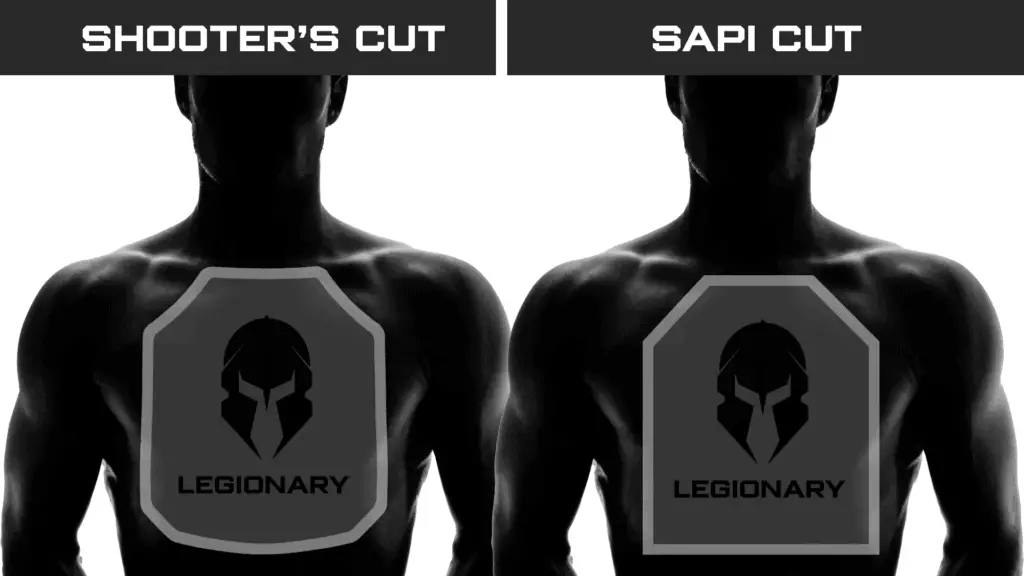
How Are They Different?
Next up, we compare SAPI and Shooter’s Cut. The major differences between SAPI and Shooter’s Cut are in these characteristics:
- Weight of body armor
- Level of protection provided
- Cost of each
- Intended use
Keep in mind, all weight comparisons are made assuming ceramic plates with level III protection and are rough as it depends on the material used and size needed.
Steel inserts tend to be the heaviest while offering the highest protection level, and soft inserts are considerably lighter, with lower protection.
SAPI Cut
- Weight: Moderately High weighing about 7 pounds, and around 14 pounds, will all plates inserted.
- Protection: Lower Shoulders, Heart, Lungs, and surrounding organs.
- Price: Higher than most, it is available to civilian buyers but is not as common as other cuts.
- Use: Offers lower maneuverability and weighs more than the swimmer and shooter’s Cut. They are used mostly for Military plating and general small arms protection.
Shooter’s Cut
- Weight: Moderate, roughly 6.5 pounds per plate. Shooter’s Cut can go in either the front or back of armor and still be effective.
- Protection: Heart, Lungs, and surrounding organs the shooter’s Cut offers protection similar to SAPI.
- Price: The most common and moderately priced. You will find a shooter’s cut variant on nearly every online store.
- Use: Offers a bit more comfort when shouldering and is lighter, the middle of the pack in comfort and usability.
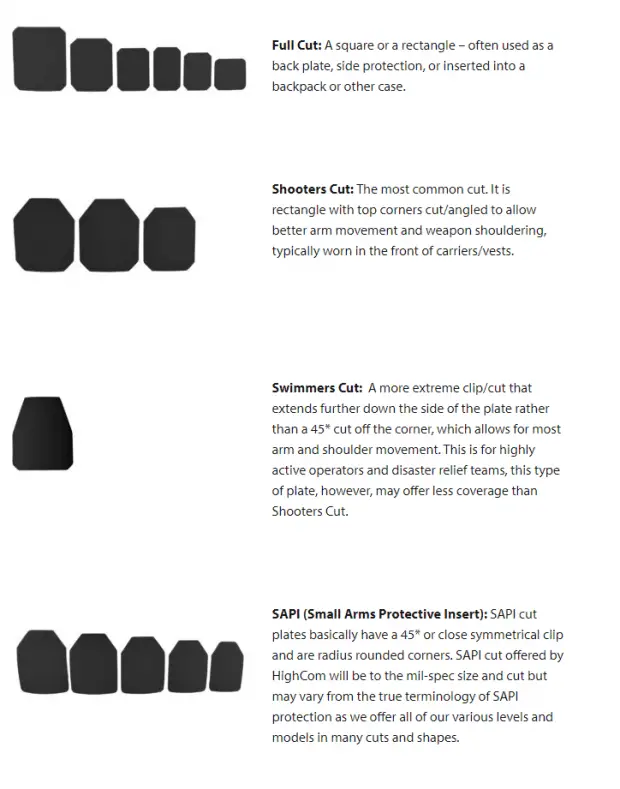
Difference in Brands
| Brand | Ceramic Plates | Steel-Core Plates | Polyethylene | Types Available |
| RTS Tactical | SAPI Cut Level IV Price: $84 (one plate ) | SAPI Cut Level IIIPrice: $69 (Set of 4- 2 SAPI Plates and 2 Side Plates) | Only SAPI Cut is available on their site.RTS Tactical has a more general appeal and more variety in other products. | |
| Spartan Armor Systems | Level IIIA, Price: $249 (Set of 2)Level III, Set of 2, 649$ Price: $649 (Set of 2)Level III+ Price: $849 (Set of 2)Level IV Price: $449 for Shooter’s Cut or $649 for SAPI (Set of 2) | Spartan Level III, 89$ single plate-174$ 2 set Price: $89 (Single plate) $174 (Set of 2)Level III + Price: $204 for Swimmer’s Cut or $224 for SAPI | Price varies depending upon Cut as nearly all of their plates offer SAPI, Shooter, and Swimmer Cut. Only the Level IV armor varies in that it only has Shooter and SAPI cuts available. Spartan has a larger selection due to a greater focus on armor and plating. | |
| Armored Republic AR500 | Level III, 65$ Single, 200$(2 plates 2 Trauma Pads) Price: $65 (Single plate) $200 (Set of 2 plates and 2 trauma pads)Level III + Price: $124 (Single) | Level III Lightweight Price: $349 (Single)Level III + Lightweight, Shooter’s Cut |
What Are the Standard Plate Sizes?
It is important to keep in mind that the plate’s size and exact dimensions will depend on the cut, material, and manufacturer. There is very little variation in terms of plate size when placed within a carrier. Using a plate carrier of a different manufacturer will most often fit within another. The US military standard, and what armorers stay around, is 9″ Wide and 12.5″ in height. When ordering your plates, double-checking the size can help alleviate the headache of not fitting in a carrier with a different cut.
How Should I Fit My Cut?
Body armor plates have been designed to stop small arms fire and save your life; however, this cannot happen if the plates do not cover your vital areas. If you are taller, looking at a plate that is a bit longer and wider can help as the opposite is true, for if you are a smaller person, seeking something shorter can help increase comfort. Manufacturers created the standard size to fit as many people as possible in the most effective manner.
When you purchase personal protective equipment, keeping in mind your own needs and body type can save your life. To measure for proper height, the site Spartan Armor Systems recommends that you draw a line from the shoulder down to the center of your torso, about two inches above your navel. For width, you should measure across the widest part of your chest. Ensure your measure just below the shoulders and about the mid of the pectoral muscle.
What Plates Should I Use for An Armored Backpack?
Putting ballistic armor into your backpack is a low impact and discreet way to ensure you always have personal protection. The size and weight of your bag will depend on the manufacturer and style that you choose. When choosing a bag, it is necessary to keep in mind that larger bags will cover more of your back and be used more effectively in a shooter situation despite the more considerable weight larger bags bring.
There is no reason to use anything but a full cut style of ceramic armor plating for a backpack. Shooter, swimmer, and original SAPI system plates all remove bits of armor for shoulder movement. The freedom offered by other cuts is not an issue when wearing the armor on your back rather than it being close to your skin within a body armor carrier.
Soft Plates vs. Hard Plates?
There is a significant difference when using soft plates or rigid plates within your plate carrier. Weight, concealability, price, maintenance, and flexibility can all impact your choice on what type of plate to choose. Soft armor is quite a bit lighter but comes at a steeper price tag while offering less protection. The lower weight of soft body armor provides flexibility and is excellent for being used under clothing.
You can also weaken hard ceramic or steel armor due to rough handling making the lighter option better if you are going to be handing or using it often. The Cut is less of an issue as the armor can flex when shooting; however, this comes at a significantly higher price point than traditional ceramics. Rigid plates are perfect for when you worry about stopping higher caliber handguns and rifle rounds. They come at the cost of a higher weight but can bring you greater peace of mind when wearing them.
Ceramic and steel plates come at a lower price tag than soft armor and are easier to replace if they take a hit. It would be best to keep in mind your preferred Cut to help inform the restriction of movement and weight you are willing to bear.
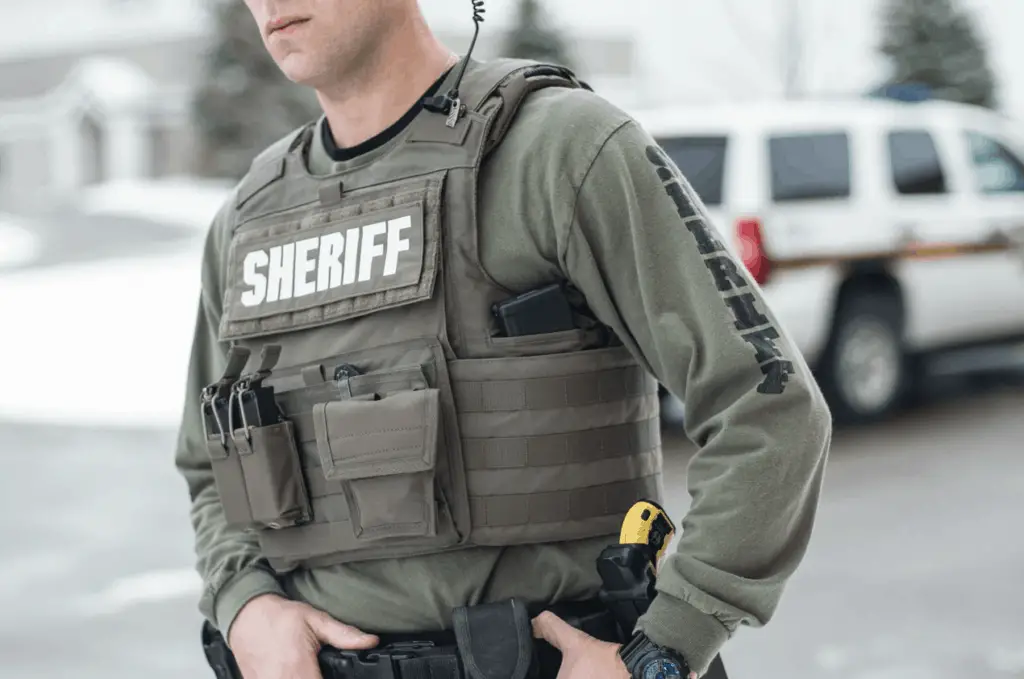
Do Either of these Work for K-9 Armor?
It is essential to ensure our canine companions’ safety, and body armor increases their protection. While soft body armor can offer protection from things such as knives or small shrapnel, you may want to consider plates to cover their more vital areas.
Armorers can create specially cut plate inserts and body armor to fit your dog. These plates are similar in composition to the SAPI set but are smaller and come in different sizes. Weighing upwards of 3 pounds per plate, you will have to ensure your dog is hardy enough to bear the burden. Despite being specially designed for dogs, the plates offered for them can stop rounds comparable to body armor designed for you and me.
How to Choose SAPI vs. Shooter’s Cut
When deciding upon your preferred Cut and material, you consider a few factors before beginning your search for a manufacturer. The decisions go deeper than just the choice of style, as keeping in mind your use, threat level, and personal ability can affect what to get. Here are the factors to keep in mind:
When Will You Be Wearing Body Armor?
In what scenarios are you going to be using the armor? Choosing between the standard SAPI or another cut can come down to what your use case is. If you are entering an area with high hostility and feel the need to be protected, utilizing a SAPI set could help alleviate anxiety.
Material and Level of Protection
What kind of material and level of protection is needed, and what grade do you need? The plate cuts are grouped and then placed within four distinct protection categories: level IIIA, III, III+, and IV. Level IIIA is the lowest and offers protection and is typically rated to stop just handgun rounds and increase in safety to level IV, rated for .30-06 rounds.
While the armor community widely considers steel inserts to be the most durable, they are considerably heavier. Soft inserts can be incredibly useful for anyone who struggles with heaving around so much extra weight. ceramic plates are much more cumbersome than soft inserts. Still, they are lighter than steel, making them a solid middle ground.
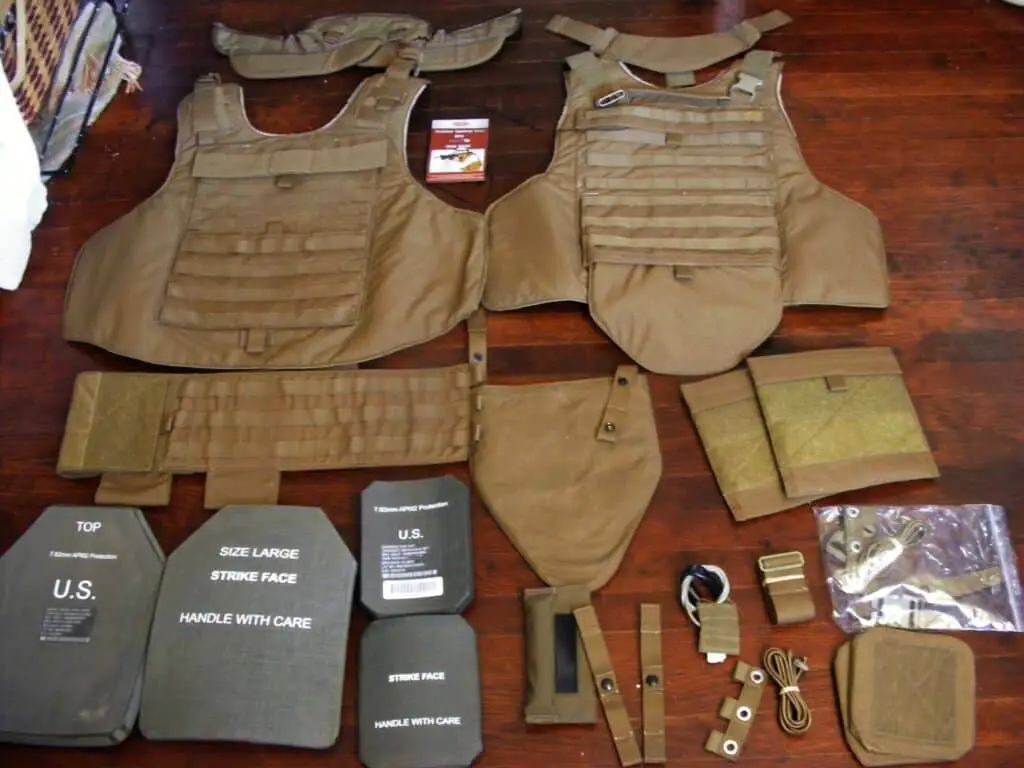
What Should I Get with SAPI and Shooter’s Cut Body Armor?
Body armor alone provides a level of protection and safety that other supplies can’t. But there are some additional supplies that you should always have on hand when you’re wearing your SAPI or Shooter’s Cut body armor.
- Trauma pads
- Armored backpack
- Sideplate
- Helmet
- First aid kit
After purchasing a carrier and plates, you may think that is all the protection you will ever need. Believing that body armor somehow makes you invincible can lead to an injury that could have otherwise been avoided.
Trauma Pads
When utilizing ceramic armor, it tends to bow inwards when struck by a higher caliber round. The energy released when stuck can bruise you or even break a rib. Trauma pads help disperse the kinetic energy if and when a round strikes your plate. These pads can reduce personal harm and make the armor more comfortable.
Armored Backpack
A backpack with an armor plate in it will very literally have your back. While a bit heavy, an armored bag is a non-aggressive appearing option with a low profile aesthetic.
Side Plates
Traditional body armor only covers the torso’s front and back, with the sides exposed often for maneuverability. Inserting side plates, while not comfortable, can increase your overall protection but comes at the cost of having a higher weight and decreasing flexibility.
A Helmet
Shielding your brain should be high on the list of things you consider when entering a dangerous scenario. Protecting your body does very little if your head is fully exposed. Having a ballistic rated helmet goes further than protecting you from projectiles as many situations where you would require a vest and plates can offer unique environmental dangers.
First Aid Kit
It may seem obvious, but getting a kit and taking a first aid training course can be a lifesaver. Body armor can protect you, but it won’t stop everything, and having the skills to treat wounds is an essential resource for survival.
Final Thoughts
Body armor is more than protection for the moment, it is also an investment in your future. For the military and police, it is essential for acting in the line of duty. Civilians, such as military contractors or those who operate in dangerous areas, can find a tremendous amount of value even if not within the line of fire. Hard plates may not be essential for everyday use; however, there is an argument to be made for utilizing soft inserts and concealable armor for personal peace of mind.
The decision to purchase personal body armor is an expensive commitment with maintenance and care requirements that you should not take likely. The differences between SAPI plates and those of the shooter or swimmer cut are relatively small regarding what kinds of rounds the armor can stop. The ability to halt a projectile depends upon the thickness and material used. The type of cut choice ultimately depends on you to decide upon your use case and the amount of weight you are willing to take.
OUR RECOMMENDED TACTICAL GEAR LIST:
- Best Health and Fitness Tracker, Whoop. Get 1 Month Free: See it here!
- EDC Assisted Opening knife we can’t live without: See it here!
- Best EDC Concealed Carry Pistol: See it here!
- Extreme Performance Morning Dink: See it here!
- Best 3D Printer For Gun Parts and Accessories: See it here!
- Our Top Rated EDC Flashlight: See it here!
- AR Red Dot Sight We Can’t Live Without: See it here!
- Best Handgun Safe For Quick Access: See it here!
- Top Wireless Security Camera For Home Security: See it here!
- The Range Bag You’ve Always Been Looking For: See it here!
- CIA Approved Sharp Shooting Course: See it here!


